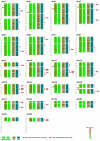Mass homozygotes accumulation in the NCI-60 cancer cell lines as compared to HapMap Trios, and relation to fragile site location - PubMed (original) (raw)
Mass homozygotes accumulation in the NCI-60 cancer cell lines as compared to HapMap Trios, and relation to fragile site location
Xiaoyang Ruan et al. PLoS One. 2012.
Abstract
Runs of homozygosity (ROH) represents extended length of homozygotes on a long genomic distance. In oncology, it is known as loss of heterozygosity (LOH) if identified exclusively in cancer cell rather than in matched control cell. Studies have identified several genomic regions which show consistent ROH in different kinds of carcinoma. To query whether this consistency can be observed on broader spectrum, both in more cancer types and in wider genomic regions, we investigated ROH patterns in the National Cancer Institute 60 cancer cell line panel (NCI-60) and HapMap Caucasian healthy trio families. Using results from Affymetrix 500 K SNP arrays, we report a genome wide significant association of ROH regions between the NCI-60 and HapMap samples, with much a higher level of ROH (11 fold) in the cancer cell lines. Analysis shows that more severe ROH found in cancer cells appears to be the extension of existing ROH in healthy state. In the HapMap trios, the adult subgroup had a slightly but significantly higher level (1.02 fold) of ROH than did the young subgroup. For several ROH regions we observed the co-occurrence of fragile sites (FRAs). However, FRA on the genome wide level does not show a clear relationship with ROH regions.
Conflict of interest statement
Competing Interests: The authors have declared that no competing interests exist.
Figures
Figure 1. NCI-60 and HapMap ROH pattern, and miRNA, FRA position.
Red arrows on the right indicate the FRAs with average upper 95th percentile ROHF larger than 0.5 in a ±5 Mb vicinity. Red asterisks indicate high ROHF bands (average upper 95th percentile ROHF>0.6) without FRA in ±5 Mb vicinity. Rare FRAs are marked by red color. The gaps between the sections of the chromosomes (for example at 130 Mb nucleotides in chromosome 1) contain the centromere. The top portion corresponds to p arm, and bottom portion corresponds to q arm.
Figure 2. Genes involved in chemotaxis.
Pathway analysis on SNPs with top ROHF difference between adult and young subgroups show the involvement of chemotaxis process. Red solid circles show genes covering SNPs with top change (see statistics section for details).
Similar articles
- Characterization and management of long runs of homozygosity in parental nucleus lines and their associated crossbred progeny.
Howard JT, Tiezzi F, Huang Y, Gray KA, Maltecca C. Howard JT, et al. Genet Sel Evol. 2016 Nov 24;48(1):91. doi: 10.1186/s12711-016-0269-y. Genet Sel Evol. 2016. PMID: 27884108 Free PMC article. - Genome-wide scan for runs of homozygosity identifies potential candidate genes associated with local adaptation in Valle del Belice sheep.
Mastrangelo S, Tolone M, Sardina MT, Sottile G, Sutera AM, Di Gerlando R, Portolano B. Mastrangelo S, et al. Genet Sel Evol. 2017 Nov 14;49(1):84. doi: 10.1186/s12711-017-0360-z. Genet Sel Evol. 2017. PMID: 29137622 Free PMC article. - Runs of homozygosity and distribution of functional variants in the cattle genome.
Zhang Q, Guldbrandtsen B, Bosse M, Lund MS, Sahana G. Zhang Q, et al. BMC Genomics. 2015 Jul 22;16(1):542. doi: 10.1186/s12864-015-1715-x. BMC Genomics. 2015. PMID: 26198692 Free PMC article. - Runs of homozygosity: current knowledge and applications in livestock.
Peripolli E, Munari DP, Silva MVGB, Lima ALF, Irgang R, Baldi F. Peripolli E, et al. Anim Genet. 2017 Jun;48(3):255-271. doi: 10.1111/age.12526. Epub 2016 Dec 1. Anim Genet. 2017. PMID: 27910110 Review. - [Runs of homozygosity and its application on livestock genome study].
Liu G, Sun FZ, Zhu FX, Feng HY, Han X. Liu G, et al. Yi Chuan. 2019 Apr 20;41(4):304-317. doi: 10.16288/j.yczz.18-287. Yi Chuan. 2019. PMID: 30992252 Review. Chinese.
Cited by
- DLX1008 (brolucizumab), a single-chain anti-VEGF-A antibody fragment with low picomolar affinity, leads to tumor involution in an in vivo model of Kaposi Sarcoma.
Eason AB, Sin SH, Shah M, Yuan H, Phillips DJ, Droste M, Shamshiev A, Dittmer DP. Eason AB, et al. PLoS One. 2020 May 14;15(5):e0233116. doi: 10.1371/journal.pone.0233116. eCollection 2020. PLoS One. 2020. PMID: 32407363 Free PMC article. - Early genetic aberrations in patients with sporadic colorectal cancer.
Druliner BR, Ruan X, Sicotte H, O'Brien D, Liu H, Kocher JA, Boardman L. Druliner BR, et al. Mol Carcinog. 2018 Jan;57(1):114-124. doi: 10.1002/mc.22738. Epub 2017 Oct 18. Mol Carcinog. 2018. PMID: 28926134 Free PMC article. - A map of mobile DNA insertions in the NCI-60 human cancer cell panel.
Zampella JG, Rodić N, Yang WR, Huang CR, Welch J, Gnanakkan VP, Cornish TC, Boeke JD, Burns KH. Zampella JG, et al. Mob DNA. 2016 Oct 31;7:20. doi: 10.1186/s13100-016-0078-4. eCollection 2016. Mob DNA. 2016. PMID: 27807467 Free PMC article. - MDP, a database linking drug response data to genomic information, identifies dasatinib and statins as a combinatorial strategy to inhibit YAP/TAZ in cancer cells.
Taccioli C, Sorrentino G, Zannini A, Caroli J, Beneventano D, Anderlucci L, Lolli M, Bicciato S, Del Sal G. Taccioli C, et al. Oncotarget. 2015 Nov 17;6(36):38854-65. doi: 10.18632/oncotarget.5749. Oncotarget. 2015. PMID: 26513174 Free PMC article. - Using CellMiner 1.6 for Systems Pharmacology and Genomic Analysis of the NCI-60.
Reinhold WC, Sunshine M, Varma S, Doroshow JH, Pommier Y. Reinhold WC, et al. Clin Cancer Res. 2015 Sep 1;21(17):3841-52. doi: 10.1158/1078-0432.CCR-15-0335. Epub 2015 Jun 5. Clin Cancer Res. 2015. PMID: 26048278 Free PMC article. Review.
References
- Knudson AG. Two genetic hits (more or less) to cancer. Nat Rev Cancer. 2001;1:157–162. - PubMed
- Shao C, Stambrook PJ, Tischfield JA. Mitotic recombination is suppressed by chromosomal divergence in hybrids of distantly related mouse strains. Nat Genet. 2001;28:169–172. - PubMed
Publication types
MeSH terms
LinkOut - more resources
Full Text Sources
Research Materials

